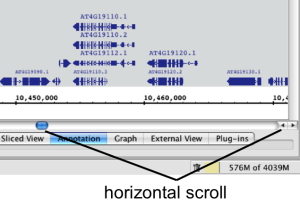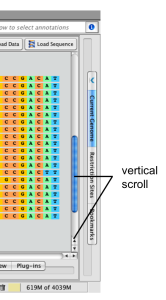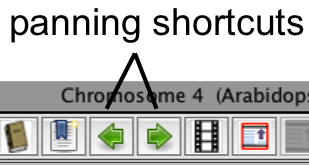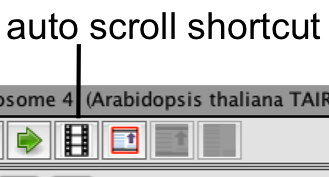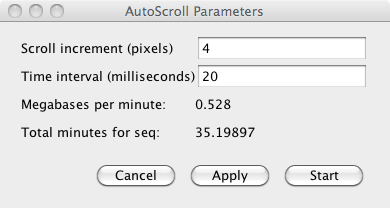| Table of Contents |
|---|
Introduction
Moving
...
the
...
IGB has multiple different methods to allow you to move around and explore your data. Each method has it's own advantages, so be sure to try them all out.
Scroll Bar
This is the 'traditional' method of moving through data. The image below shows the horizontal scroll bar, with directional arrows at the end. The scroll bar is used by dragging to the left or right. One note about the scroll bar is that it moves a defined number of pixels, irrespective of zoom level; i.e. at very high zoom (zoomed in), using the scroll bar will send you 'flying' through your data, and you may lose the area you were looking at. On the other hand, this is the fastest method of movement at lower zoom levels (zoomed out).
Clicking and holding on either arrow at the end of the scroll bar will allow for slow movement of the image in the direction of the arrow. This is the slowest method of moving through the image, although it can be useful at the highest zoom levels (zoomed in).
Click-Drag
The scroll bar is the fastest movement, and the scroll bar arrows are the slowest movement. The click-drag method (and the click-pull method) provide controlled, moderate speed movement through the data. To use the click-drag, you use the 'pointer' cursor. Click anywhere near the edge of the image, and while the mouse button is depressed, drag the cursor to the edge of the image; as the cursor gets to the edge of the image, the image will begin scrolling in the opposite direction (see image below). This click-drag movement is reminiscent of the scrolling movement seen in many word processing programs, where the cursor is used to selected text and then begin scrolling/selecting further into the document.
Grab-Drag
This a new feature as of IGB 6.5. Here, you select the 'hand' cursor, by clicking the 'hand' box. You click the cursor in the image ('grab'), and you 'drag' the image in the direction you want it to move. This allows the image and the cursor to move in the same direction (the opposite of click-drag method) (see image below). After moving to an area of interest, you will need to reset the cursor to the arrow (click the arrow box) in order to select annotations or elements within the image.
Autoscroll
This is a very useful feature for moving through images of large data sets. You can set the speed of movement in the window (see image below), and IGB display without changing zoom level is called "panning," a term borrowed from film. Panning is also called "scrolling."
When you are zoomed in, only part of your data are visible and much of it is off-screen. The data display area is like the viewfinder of a camera that only shows you part of the surrounding scene. Use IGB's panning controls to move the data display area and view a different part of the genomic data scene.
Because moving through the data scene is an key aspect of data exploration and analysis, IGB offers many ways to pan the display.
To pan the display in IGB, you can
- Click-drag using the Move tool
- Use the horizontal or vertical scrollbars
- Click-drag the selection tool right or left
- Click the toolbar panning shortcuts
- Turn on Auto scroll
Grab tool
The Move tool allows you to move in any direction by click-dragging the display.
To use the Move tool
- Select the Move tool
- Click and drag the display to move in any direction
Scrollbars
The horizontal and vertical scrollbars move the display up and down, similar to how scrollbars function in other applications.
To pan the display using the scrollbars, click the gutter or click-drag the thumb from left to right. You can also click the ends of the scrollbar.
Horizontal scrollbar (click to enlarge)
Vertical scrollbar (click to enlarge)
| Note |
|---|
Horizontal scroll works best when you're zoomed out. |
Click-drag left or right
Click-drag the Selection tool into the left or right side of the data display area to move left or right.
To move left or right using the Selection tool
- Select the Selection tool
- Click and hold the mouse in an empty area of the data display area
- Drag the mouse into the left or right edge of the display
- Release the mouse to stop scrolling
Arrow toolbar shortcuts
You can use the right and left arrow shortcuts to pan left or right.
Auto Scroll
Use Auto Scroll to scan through large regions at medium zoom levels. IGB will move through the image, from left to right, at a set speed . Autoscroll can be accessed through the View menu. To make starting and stopping the Autoscroll function even easier, you can set a keyboard shortcut for it. Go to File > Preferences > Shortcuts, and set a shortcut key.
Resolution reflects the zoom level of the image. This can be set by hand, or just left 'as is' if you have already gone to the zoom level you prefer. Scroll increment is how far it shifts the image each time it moves; Time interval is how fast the image moves. These three elements work together to affect the speed at which you see data move past. We recommend setting the zoom level based on the image, then adjust the time or scroll until it is moving at a level comfortable for you. Megabases per minute and Total minutes for seq. will give you an idea of the final Autoscroll speed.you define.
To activate autoscroll
- Click the Autoscroll icon in the toolbar
or
- Select Tools > Start Auto Scroll.
To set auto scroll speed
- Select Tools > Configure Auto Scroll...
- Enter values
- Click Apply to apply the new speed settings
- Click Start to start auto scroll
Auto Scroll configuration window

